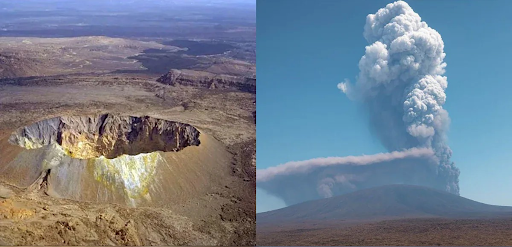




Disclaimer: Copyright infringement not intended.
Jammu & Kashmir government focuses on ecotourism development in Bangus Valley to prevent unchecked urbanization, preserve ecological balance & support local livelihoods especially after facing issues in Pahalgam, Gulmarg, Sonamarg.
Bangus Valley is located in northern part of Jammu & Kashmir within Kupwara district & Handwara sub-district.
Situated at an altitude of approximately 10,000 feet above sea level it lies within the Trans-Himalayan region.
The valley is characterized by its diverse ecosystems blending mountain & grassland biomes with lush flora at lower altitudes & Taiga (coniferous) forests at higher elevations.
The valley spans over an estimated 300 square kilometers & consists of two major sections: Bodh Bangus (Big Bangus) & Lokut Bangus (Small Bangus).
The main valley Bodh Bangus is a linear, elliptical bowl aligned along east-west axis. It is surrounded by high mountain ranges:
To the east valley is bordered by Rajwar & Mawar mountains. To west, Shamasbury & Dajlungun mountain ranges form boundary. To the north, Chowkibal & Karnah Guli mountains enclose the valley.
A smaller valley Lokut Bangus lies on the northeastern side of the main valley creating a picturesque landscape with meadows & dense forests.
Bangus Valley experiences a cold alpine climate with long, harsh winters & moderate summers.
Snowfall is common during winter & region flora is adapted to withstand extreme cold.
The coniferous forests surrounding the valley are primarily composed of pine, deodar, fir trees.
A stream flows through both the Bodh Bangus & Lokut Bangus valleys nourishing vegetation & contributing to overall ecological system.
|
Feature |
Details |
|
Location |
North of the Great Himalayas, extending from Zanskar in India to Tibet and Karakoram. |
|
Length |
Approximately 1,600 km. |
|
Regions Covered |
Primarily parts of India, Pakistan, China (Tibet), and Nepal. |
|
Mountain Ranges |
Includes Zanskar, Ladakh, Kailash Range, Karakoram, and Lahaul. |
|
Altitude |
Peaks generally range from 4,500 meters to 7,500 meters. |
|
Ecological Features |
Characterized by cold deserts, high-altitude passes, and arid plateaus. |
|
Flora |
Sparse vegetation; mainly alpine and steppe-like vegetation such as grasses, shrubs, and low-lying plants. |
|
Fauna |
Musk deer, snow leopards, mountain goats, wild yaks, ibex, brown bears, and snowcocks. |
|
Climate |
Extreme cold; arid and dry in most areas, with snowfall during winters. |
|
Importance |
Serves as the boundary between the Indian subcontinent and the Tibetan Plateau. |
|
Significance |
Ecologically important for maintaining biodiversity and climatic balance; a barrier to monsoon winds, leading to desertification of regions in the north. |
|
Human Inhabitants |
Limited human habitation, mainly nomadic tribes, Buddhist communities, and mountain villagers. |
|
Strategic Importance |
Plays a crucial role in border security between India, Pakistan, and China due to its proximity to the Line of Control (LoC) and Indo-China border. |
|
Popular Regions |
Ladakh, Zanskar Valley, Lahaul, Kailash Mansarovar, Karakoram Range, and Spiti Valley. |
|
Eco-Tourism Spot |
Location |
Key Features |
Activities |
Best Time to Visit |
|
Nanda Devi Biosphere Reserve |
Uttarakhand |
A UNESCO World Heritage Site with rich biodiversity, home to the Nanda Devi Peak and diverse flora and fauna. |
Trekking, wildlife watching, nature walks, bird watching |
April to June, September to November |
|
Sundarbans Mangrove Forest |
West Bengal |
UNESCO-listed mangrove forest, home to the Royal Bengal tiger and other endangered species. |
Boat rides, wildlife safari, bird watching, photography |
October to March |
|
Kanha National Park |
Madhya Pradesh |
One of India’s largest national parks, famous for its tiger conservation and rich flora. |
Wildlife safari, jeep safaris, nature walks |
November to March |
|
Great Himalayan National Park |
Himachal Pradesh |
UNESCO World Heritage site with high-altitude trekking routes and diverse ecosystems. |
Trekking, camping, wildlife watching, photography |
May to October |
|
Periyar Wildlife Sanctuary |
Kerala |
Famous for its elephant population and Periyar Lake; part of the Western Ghatsecosystem. |
Boating, wildlife safari, nature walks, eco-tours |
October to March |
|
Ranthambhore National Park |
Rajasthan |
Known for its large population of tigers and rich history with the Ranthambhore Fort. |
Tiger safari, wildlife photography, bird watching |
October to April |
|
Coorg (Kodagu) |
Karnataka |
Known for its coffee plantations, lush landscapes, and rich wildlife. |
Coffee plantation tours, trekking, wildlife spotting |
October to March |
|
Valley of Flowers National Park |
Uttarakhand |
UNESCO-listed, famous for its diverse floraand wildflowers at high altitudes. |
Trekking, nature walks, photography |
July to September |
|
Manas National Park |
Assam |
UNESCO World Heritage Site, famous for its tigers, elephants, and rhinoceroses. |
Wildlife safari, river rafting, bird watching |
November to April |
|
Banni Grasslands Reserve |
Gujarat |
Known for its wildlife, especially migratory birds and local Rabari tribes. |
Bird watching, cultural tours, photography |
November to February |
|
Tawang |
Arunachal Pradesh |
A hidden gem with Buddhist monasteries, snow-capped peaks, and unique tribal cultures. |
Trekking, monastery visits, cultural tours |
March to October |
|
Alleppey (Alappuzha) |
Kerala |
Famous for its backwaters, houseboats, and eco-friendly resorts. |
Houseboat ride, canoeing, bird watching, village tours |
November to February |
|
Agasthyakoodam |
Kerala |
The second highest peak in the Western Ghats with a diverse range of flora and fauna. |
Trekking, nature walks, bird watching |
December to April |
|
Dandeli Wildlife Sanctuary |
Karnataka |
Rich in biodiversity with tigers, elephants, and leopards. |
River rafting, jungle safari, nature walks, bird watching |
October to May |
|
Chilika Lake |
Odisha |
Asia’s largest brackish water lagoon, famous for migratory birds and dolphins. |
Bird watching, boat ride, fishing, photography |
November to February |
Sources:
|
PRACTICE QUESTION Q. Discuss role of eco-tourism in promoting sustainable development in India. Evaluate its impact on local communities & environment with examples from prominent eco-tourism destinations. |







© 2025 iasgyan. All right reserved